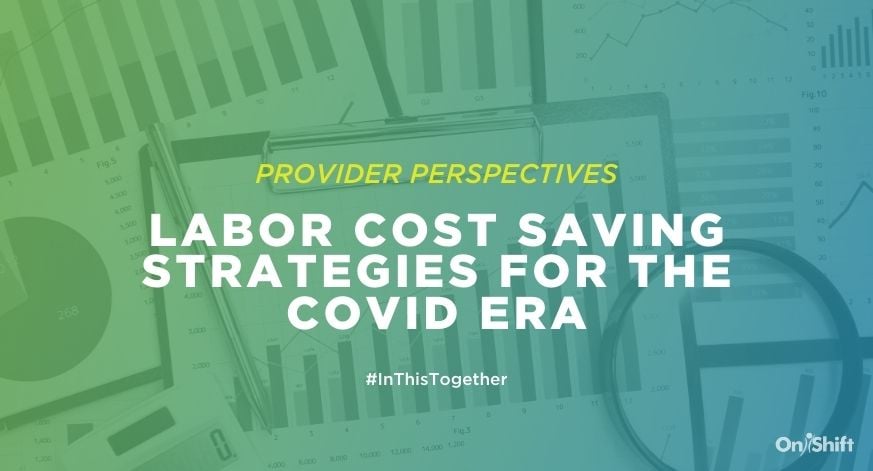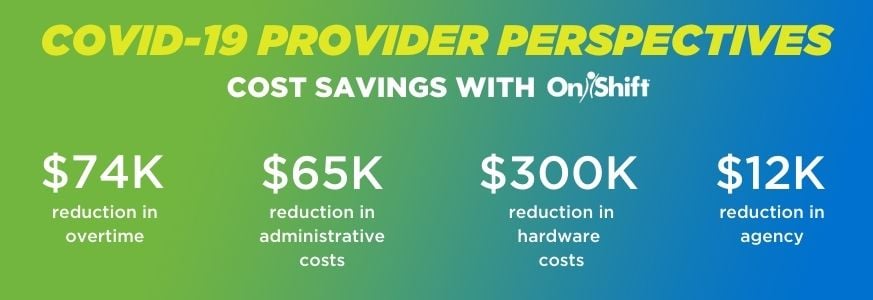November 13, 2020 | Marti Bowman
November 13, 2020 | Marti Bowman
 Lower occupancy, massive PPE costs, testing expenses and increased reliance on overtime and agency staff are the reality for the majority of senior care providers today. And according to Mark Parkinson, President and CEO of the American Health Care Association (AHCA), even with a vaccine in the near future, it will likely take a couple of years for census to recover.
Lower occupancy, massive PPE costs, testing expenses and increased reliance on overtime and agency staff are the reality for the majority of senior care providers today. And according to Mark Parkinson, President and CEO of the American Health Care Association (AHCA), even with a vaccine in the near future, it will likely take a couple of years for census to recover.
Helping senior care organizations navigate the pandemic’s uncertainties, workforce impact and added expenses has been and continues to be the top priority for us at OnShift. Every day we talk with senior care professionals, from caregivers and associates, to executive directors and senior leadership, about the ins and outs of the pandemic and how it’s affecting them and their communities. Our goal throughout this ordeal has been clear: to help you get through this. In addition to our world-class workforce technology platform, our team offers best practices, coaching, reporting and ongoing consultation so we can help you through this. Simply put, we are in this together.
This post is the first in a series examining workforce management strategies, supported by technology, that are making a big difference in eliminating excess costs, improving efficiencies and streamlining operations so leadership and associates can focus on what matters most – caring for residents and patients.
Eliminate Unnecessary Labor Costs
Visibility into staffing has always been important. And in today’s climate, it’s essential to stay ahead of schedule changes and the costs associated with them. This means taking a proactive approach to labor management, continually adjusting staffing by managing to employee and resident needs along with real-time metrics such as census/occupancy, employee utilization, overtime, open shifts and punch discrepancies.
To achieve this, many of OnShift’s clients look to our automated daily reports and quick-view labor management dashboards to proactively make schedule changes in order to reduce excess labor costs and avoid staffing inconsistencies. To maximize results, it’s important to ensure these metrics are visible at all levels—from corporate to regional to community.

For the Good Samaritan Society – Sanford Health, these metrics, paired with daily labor management practices and conversations at all levels, helped reduce costly overtime by 1,480 hours in one region for an estimated savings of $42k in just two months, despite the many obstacles presented by the pandemic. Another organization reduced overtime by 80% in one region over the past three months, resulting in an estimated savings of $74k.
Minimize Agency Spend
While overtime costs can quickly add up, it often comes at a fraction of the cost of agency. However, due to the current circumstances, many have had to increase their reliance on agency staff—a major hit to their bottom line.
Minimizing agency spend starts with understanding which shifts you most often rely on these workers and how early those shifts are being filled with agency staff. Next, look at the utilization of your current employees, particularly full-time employees who may not be working full-time hours, as well as per diem staff with capacity. Finally, communicate those shifts to all those available and eligible employees.
These simple steps can go a long way in reducing agency. For one provider, these tactics helped reduce agency by 40%, resulting in an estimated savings of $12,000. Having daily visibility into agency usage, open shifts and utilization not only helps decrease excess labor costs but can boost employee engagement as staff have more of a say in when they work.
Save Time To Save Even More
Eliminating the manual effort involved in key administrative staffing tasks not only saves time, but also frees up managers so they can focus on other things. This can pay off big for a senior care organization, especially during a pandemic that has added so many complexities with testing requirements, infection control and policy changes.
Managing open shifts is often time-consuming and headache-prone. And this is often because there is a lack of collaboration between the schedulers themselves and your employees. In order to reduce these scheduling headaches, it’s essential that caregivers are able to become a part of the scheduling process. This means giving them the ability to easily view and request open shifts, while also streamlining approvals.
OnShift Schedule offers a more collaborative scheduling process by giving staff easy access to view and request open shifts. If that employee is not at risk of overtime, OnShift’s rules-based auto-approve capabilities help eliminate another manual task by automatically approving employee shift requests. In addition, filling call-offs has taken on greater importance during the pandemic. In fact, our clients experienced a 28% increase in call-offs in the early months of the crisis. Fortunately, OnShift is helping senior care organizations efficiently fill shifts with streamlined call-off and open shift management.
Our clients love this and they are experiencing major savings! In fact, during the pandemic one senior care client saved 3800 hours with OnShift’s auto-approve and shift management, for an estimated administrative cost savings of nearly $65k. (And their employees are pleased with their schedules that are driven by their own requests.)
Reduce Excess Hardware Costs
As you begin examining where to cut excess costs, you’re likely ignoring something your employees use every day—the timeclock. A relic of the past, timeclocks are costly, prone to inaccuracies, and faulty, often requiring internal resources to maintain.
Providers often spend up to $4000 per clock to own, or $250 per month to lease. Eliminating this expense delivers major savings—which can be reinvested elsewhere in the organization. OnShift Time eliminates the need for costly, traditional timeclocks. This modern time and attendance software enables staff to punch using virtually any mobile device—including a tablet or their personal smartphone.
For one large multi-community provider, moving to a more mobile approach gave them an immediate cost savings of upwards of $300k.
The use of personal devices brings employees a contactless punch experience, eliminating yet another common touchpoint in the community during COVID. OnShift Time also comes standard with configurable COVID-19 questionnaires which screen all staff for common symptoms of the virus at punch in. And it’s these small changes that can have a big impact on slowing the spread of the virus within your community.
Additionally, the insights within OnShift Time can help curb excess labor costs caused by time theft. State of the art facial recognition biometrics eliminate buddy punching, while real-time alerts notify managers and supervisors of the most common form of time theft—clock riding.
Labor Cost Management Is Real
These are just a few of the ways our clients are partnering with OnShift to control their largest expense – labor. The entire team at OnShift remains committed to helping senior care providers manage through COVID-19. Look for the next posts in this series to learn more about how our clients are streamlining processes and creating efficiencies through recruitment, hiring and retention strategies.
#InThisTogether
Subscribe to the OnShift Blog
Recent Posts
Categories
About Marti Bowman
As Chief Marketing Officer, Marti brings significant experience leading go-to-market strategies, product marketing, communications and PR programs for technology startups as well as Fortune 500 organizations. Prior to OnShift, Marti was a principal product director at Oracle, where she drove global go-to-market strategies for the Oracle Fusion Middleware product portfolio. She joined Oracle through the acquisition of BEA Systems, where she was a product marketing manager.
See for yourself why thousands of providers rely on OnShift’s innovative software for recruitment, hiring, workforce management, pay and engagement. Request your personalized demo today.
